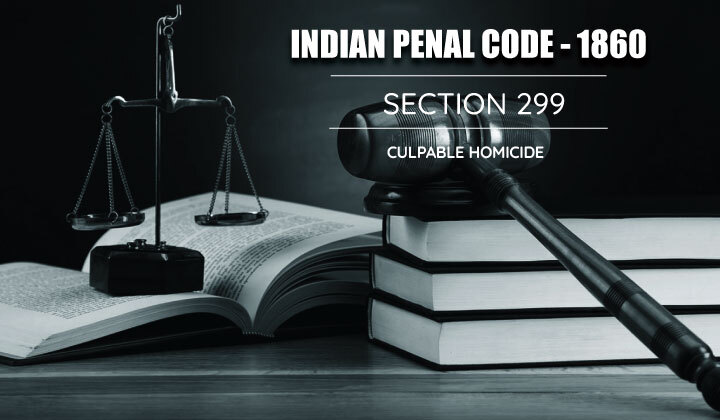Section 299 - Culpable Homicide

Section 299 of Indian penal code 1860 defines Culpable homicide as Whoever causes death by doing an act with the intention of causing death, or with the intention of causing such bodily injury as is likely to cause death, or with the knowledge that he is likely by such act to cause death, commits the offence of culpable homicide. Illustration: A places sticks and turf over a pit with the goal of inflicting death, or with the knowledge that death will result. Z treads on the firm ground falls in and is killed. The crime of culpable homicide was committed by A. Z is hiding behind a shrub, which A is aware of. B is completely unaware of this. A causes B to shoot at the bush with the intent of killing Z or knowing that it is likely to kill Z. Z is killed by B's firing. B may not have committed any wrongdoing, but A has committed responsible homicide. A kills B, who is hiding behind a bush, by firing at a fowl with the goal to kill and steal it. Despite the fact that A committed illegal conduct, he was not guilty of culpable murder since he did not plan to kill B or cause death by performing an act he knew would cause death. Explanation 1.— A person who causes bodily injury to another who is suffering from a condition, disease, or bodily infirmity, thereby hastening his death, is regarded to have caused his death. Explanation 2: When death is caused by bodily injury, the person who causes the bodily injury is judged to have caused the death, even if the death could have been avoided by using suitable remedies and skilled care. Explanation 3.— It is not homicide to cause a child's death in the mother's womb. However, if any part of a living child has been brought forth, even if the kid has not yet breathed or been fully born, it may be considered responsible for the murder. Consult the best lawyer online Culpable Homicide amounting to Murder: Murder falls under Section 300 of the Indian Penal Code 1862, which states: If the act is done with the intent of causing death or causing such bodily injury as is likely to cause death of the person, or if the inflicted bodily injury is sufficient in the ordinary course of nature to cause death, or if there is knowledge that the act is so fatal that it will almost certainly cause death, it is culpable homicide. Illustration: X is aware that Z has a brain tumour, so he repeatedly hits him with a bat on the head in an attempt to kill him, and Z dies as a result. Murder is X's fault
Is IPC 299 bailable?
Punishment for section 299 IPC is defined under section 304 which is a Non-bailable offence and Any other offence is considered a non-bailable offence. Bailable offences are regarded to be less serious and grave. Murder, for example, is a terrible and dangerous offence that is subject to bail. Bail is requested as a matter of right in cases where the offence is bailable. Bail is a discretionary matter for non-bailable offences.
What is the punishment of IPC 299 cases?
According to Section 304 of the Indian Penal Code, whoever causes death with intent or causes bodily injury that is likely to cause death or with the knowledge that death is likely to be caused as a result of the act, shall be liable to life imprisonment or imprisonment of either description for a term which may extend to ten years, and shall also be liable to fine
Second, anyone who causes death without intending to cause death or physical injury likely to cause death, or who has no knowledge that his actions could cause death, shall be sentenced to either type of imprisonment for a time up to ten years, as well as a fine.
If the act that causes death is done with the knowledge that it is likely to cause death, the offender will be sentenced to either type of imprisonment for a time up to 10 years, as well as a fine.
Is IPC 299 a Cognizable or Non-cognizable offence?
Punishment for section 299 is defined under section 304 which is Cognizable offence and A cognizable offence is one in which a police officer, under the first schedule or any other legislation in effect at the times, can arrest a suspect without a warrant and begin an investigation without the consent of the court.
How do you file/defend a case under section 299?
It's difficult to fight a criminal charge. You must comprehend the elements of the offence with which you have been accused and determine whether you have any defences to each. You don't need to deny all of the elements since the jury only needs to believe one of them. While each case is unique, the following are some of the most popular criminal defences. If the defendant is defending himself under Indian Penal Code Section 299, he should hire an attorney and work according to the facts and circumstances of the case.
Hire an experienced criminal lawyer to draft your complaint so that it is not dismissed by the police for any reason.
If police officers fail to record your FIR, you can file a formal complaint with the station's Superintendent. A skilled attorney will fight hard in court to defend your case and will almost probably be able to help you, either by dismissing your case or reducing your sentence.
Case law
Nara Singh Challan v. State of Orissa (1997): Section 299 of the Indian Penal Code is the genus, and Section 300 of the Indian Penal Code is the species, according to the case of Nara Singh Challan v. State of Orissa (1997). As a result, there are no separate sections dealing with culpable homicide that does not amount to murder; instead, the definition of murder is found in Section 300 of the IPC.
Get in touch with the best lawyer online
Observation: “The IPC has split culpable homicide into three degrees for determining the right punishment that is proportionate to the current act. The first is Murder, which is defined under Section 300 of the Indian Penal Code, the second is the culpable homicide of the second degree, which is punishable under Section 304 part 1 of the Indian Penal Code, and the third is the lowest degree of culpable homicide, which is punishable under Section 304 part 2 of the Indian Penal Code.
In Shanmugam v. State of T.N., the Court of Sessions decided that Section 304 offences are cognizable, non-bailable, and triable by the Court of Sessions. A feud grew between the accused and the deceased as a result of this. During the altercation, the accused stabbed the victim in the abdomen and chest with a spear, causing septicemia and death. Part I of Section 304 of the IPC was used to sentence the defendant to life in prison.
As we can see, Section 300 Exception 4 applies in this circumstance. As a result, Section 299 of the IPC would apply. Because it was obvious from the circumstances that there was a clear intention to cause death or bodily injury likely to cause death, Part 1 of Section 304 was triggered.
This article on IPC Section 454 is written by Mr. Abhinav Kumar, a Final year student at the University of Petroleum and Energy Studies, Dehradun.| Offence | Punishment | Cognizance | Bail | Triable By |
|---|---|---|---|---|
| NA | NA | NA | NA | NA |
| Offence | NA |
|---|---|
| Punishment | NA |
| Cognizance | NA |
| Bail | NA |
| Triable By | NA |


